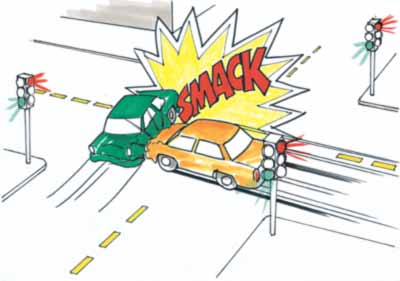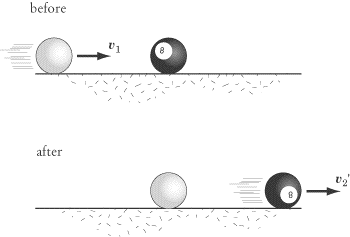Main Page
Welcome to the Georgia Tech Wiki for Intro Physics. This resources was created so that students can contribute and curate content to help those with limited or no access to a textbook. When reading this website, please correct any errors you may come across. If you read something that isn't clear, please consider revising it!
Looking to make a contribution?
- Pick a specific topic from intro physics
- Add that topic, as a link to a new page, under the appropriate category listed below by editing this page.
- Copy and paste the default Template into your new page and start editing.
Please remember that this is not a textbook and you are not limited to expressing your ideas with only text and equations. Whenever possible embed: pictures, videos, diagrams, simulations, computational models (e.g. Glowscript), and whatever content you think makes learning physics easier for other students.
Source Material
All of the content added to this resource must be in the public domain or similar free resource. If you are unsure about a source, contact the original author for permission. That said, there is a surprisingly large amount of introductory physics content scattered across the web. Here is an incomplete list of intro physics resources (please update as needed).
- A physics resource written by experts for an expert audience Physics Portal
- A wiki book on modern physics Modern Physics Wiki
- The MIT open courseware for intro physics MITOCW Wiki
- An online concept map of intro physics HyperPhysics
- Interactive physics simulations PhET
- OpenStax algebra based intro physics textbook College Physics
- The Open Source Physics project is a collection of online physics resources OSP
- A resource guide compiled by the AAPT for educators ComPADRE
Organizing Categories
These are the broad, overarching categories, that we cover in two semester of introductory physics. You can add subcategories or make a new category as needed. A single topic should direct readers to a page in one of these catagories.
Interactions
- Kinds of Matter
- Detecting Interactions
- Escape Velocity
- Fundamental Interactions
- Determinism
- System & Surroundings
- Free Body Diagram
- Newton's First Law of Motion
- Newton's Second Law of Motion
- Newton's Third Law of Motion
- Gravitational Force
- Electric Force
- Conservation of Energy
- Conservation of Charge
- Terminal Speed
- Simple Harmonic Motion
- Speed and Velocity
- Electric Polarization
- Perpetual Freefall (Orbit)
- 2-Dimensional Motion
- Center of Mass
- Reaction Time
- Time Dilation
- Pauli exclusion principle
Modeling with VPython
Theory
Notable Scientists
- Alexei Alexeyevich Abrikosov
- Christian Doppler
- Albert Einstein
- Ernest Rutherford
- Joseph Henry
- Michael Faraday
- J.J. Thomson
- James Maxwell
- Robert Hooke
- Carl Friedrich Gauss
- Nikola Tesla
- Andre Marie Ampere
- Sir Isaac Newton
- J. Robert Oppenheimer
- Oliver Heaviside
- Rosalind Franklin
- Enrico Fermi
- Robert J. Van de Graaff
- Charles de Coulomb
- Hans Christian Ørsted
- Philo Farnsworth
- Niels Bohr
- Georg Ohm
- Galileo Galilei
- Gustav Kirchhoff
- Max Planck
- Heinrich Hertz
- Edwin Hall
- James Watt
- Count Alessandro Volta
- Josiah Willard Gibbs
- Richard Phillips Feynman
- Sir David Brewster
- Daniel Bernoulli
- William Thomson
- Leonhard Euler
- Robert Fox Bacher
- Stephen Hawking
- Amedeo Avogadro
- Wilhelm Conrad Roentgen
- Pierre Laplace
- Thomas Edison
- Hendrik Lorentz
- Jean-Baptiste Biot
- Lise Meitner
- Lisa Randall
- Felix Savart
- Heinrich Lenz
- Max Born
- Archimedes
- Jean Baptiste Biot
- Carl Sagan
- Eugene Wigner
- Marie Curie
- Pierre Curie
- Werner Heisenberg
- Johannes Diderik van der Waals
- Louis de Broglie
- Aristotle
- Émilie du Châtelet
- Blaise Pascal
- Siméon Denis Poisson
- Benjamin Franklin
- James Chadwick
- Henry Cavendish
- Thomas Young
- James Prescott Joule
- John Bardeen
- Leo Baekeland
- Alhazen
- Willebrord Snell
- Fritz Walther Meissner
- Johannes Kepler
- Johann Wilhelm Ritter
- Philipp Lenard
- Robert A. Millikan
- Joseph Louis Gay-Lussac
- Guglielmo Marconi
- William Lawrence Bragg
- Robert Goddard
- Léon Foucault
- Henri Poincaré
- Steven Weinberg
- Arthur Compton
- Pythagoras of Samos
- Subrahmanyan Chandrasekhar
- Wilhelm Eduard Weber
- Edmond Becquerel
- Joseph Rotblat
- Carl David Anderson
- Hermann von Helmholtz
- Nicolas Leonard Sadi Carnot
- Wallace Carothers
- David J. Wineland
- Rudolf Clausius
- Edward L. Norton
- Shuji Nakamura
- Pierre Laplace Pt. 2
- William B. Shockley
- Osborne Reynolds
- Alexander Graham Bell
- Hans Bethe
- Erwin Schrodinger
- Wolfgang Pauli
- Paul Dirac
- Bill Nye
- Arnold Sommerfeld
- Albert A. Micheleson and Edward W. Morley
- James Franck
- Chen-Ning Yang
Properties of Matter
Contact Interactions
Momentum
- Vectors
- Kinematics
- Conservation of Momentum
- Predicting Change in multiple dimensions
- Derivation of the Momentum Principle
- Momentum Principle
- Impulse Momentum
- Curving Motion
- Projectile Motion
- Multi-particle Analysis of Momentum
- Iterative Prediction
- Analytical Prediction
- Newton's Laws and Linear Momentum
- Net Force
- Center of Mass
- Momentum at High Speeds
- Change in Momentum in Time for Curving Motion
- Momentum with respect to external Forces
Angular Momentum
- The Moments of Inertia
- Moment of Inertia for a cylinder
- Rotation
- Torque
- Systems with Zero Torque
- Systems with Nonzero Torque
- Torque vs Work
- Angular Impulse
- Right Hand Rule
- Angular Velocity
- Predicting the Position of a Rotating System
- Translational Angular Momentum
- The Angular Momentum Principle
- Angular Momentum of Multiparticle Systems
- Rotational Angular Momentum
- Total Angular Momentum
- Gyroscopes
- Angular Momentum Compared to Linear Momentum
- Torque 2
Energy
- The Photoelectric Effect
- Photons
- The Energy Principle
- Predicting Change
- Rest Mass Energy
- Kinetic Energy
- Potential Energy
- Work
- Work and Energy for an Extended System
- Thermal Energy
- Conservation of Energy
- Electric Potential
- Energy Transfer due to a Temperature Difference
- Gravitational Potential Energy
- Point Particle Systems
- Real Systems
- Spring Potential Energy
- Internal Energy
- Translational, Rotational and Vibrational Energy
- Franck-Hertz Experiment
- Power (Mechanical)
- Transformation of Energy
- Energy Graphs
- Air Resistance
- Electronic Energy Levels
- Second Law of Thermodynamics and Entropy
- Specific Heat Capacity
- The Maxwell-Boltzmann Distribution
- Electronic Energy Levels and Photons
- Energy Density
- Bohr Model
- Quantized energy levels
- Path Independence of Electric Potential
- Energy in a Circuit
- The Photovoltaic Effect
Collisions
Collisions are events that happen very frequently in our day-to-day world. In the realm of Physics, a collision is defined as any sort of process in which before and after a short time interval there is little interaction, but during that short time interval there are large interactions. When looking at collisions, it is first important to understand two very important principles: the Momentum Principle and the Energy Principle. Both principles serve use when talking of collisions because they provide a way in which to analyze these collisions. Collisions themselves can be categorized into 3 main different types: elastic collisions, inelastic collisions, maximally inelastic collisions. All 3 collisions will get touched on in more detail further on.
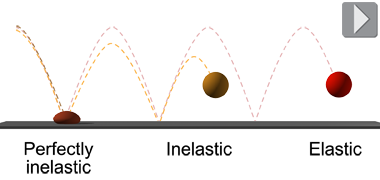
A collision is deemed "elastic" when the internal energy of the objects in the system does not change (in other words, change in internal energy equals 0). Because in an elastic collision no kinetic energy is converted over to internal energy, in any elastic collision Kfinal always equals Kinitial.
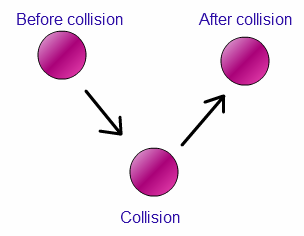
A collision is said to be "inelastic" when it is not elastic; therefore, an inelastic collision is an interaction in which some change in internal energy occurs between the colliding objects (in other words, change in internal energy does not equal 0). Examples of such changes that occur between colliding objects include, but are not limited to, things like they get hot, or they vibrate/rotate, or they deform. Because some of the kinetic energy is converted to internal energy during an inelastic collision, Kfinal does not equal Kinitial. There are a few characteristics that one can search for when identifying inelasticity. These indications include things such as:
- Objects stick together after the collision
- An object is in an excited state after the collision
- An object becomes deformed after the collision
- The objects become hotter after the collision
- There exists more vibration or rotation after the collision
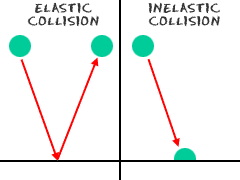
Maximally inelastic collisions, also known as "sticking collisions", are the most extreme kinds of inelastic collisions. Just as its secondary name implies, a maximally inelastic collision is one in which the colliding objects stick together creating maximum dissipation. This does not automatically mean that the colliding objects stop dead because the law of conservation of momentum. In a maximally inelastic collision, the remaining kinetic energy is present only because total momentum can't change and must be conserved.
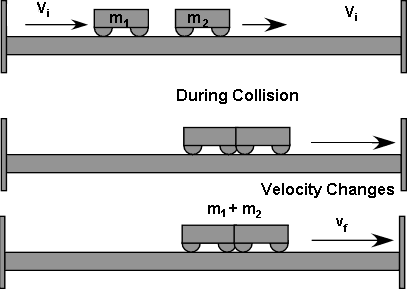
The easiest way to understand this phenomenon is to look at it through an example. In this case, we can analyze it through the common game of billiards. Taking the two, equally massed billiard balls as the system, we can neglect the small frictional force exerted on the balls by the billiard table. The Momentum Principle states that in this head-on collision of billiard balls the total final momentum in the x direction must equal the total initial momentum. However, this alone does not give us the knowledge to know how the momentum will be divided up between the two balls. Considering the law of conservation of energy, we can more accurately depict what will happen. This will also allow for one to identify what kind of collision occurs (elastic, inelastic, or maximally inelastic). It is important to know that head-on collisions of equal masses do not have a definite type of collision associated with it.
Just as with head-on collisions of equal masses, it is easy to understand head-on collisions of unequal masses by viewing it through an example. Let's take for example two balls of unequal masses like a ping-pong ball and a bowling ball. For the purpose of this example (so as to allow for no friction and no other significant external forces), let's imagine these objects collide in outer space inside an orbiting spacecraft. If there were to be a collision between the two, what would one expect to happen? One could expect to see the ping-pong ball collide with the bowling ball and bounce straight back with a very small change of speed. What one might not expect as much is that the bowling ball also moves, just very slowly. Again, this can all be explained through the conservation of momentum and the conservation of energy.
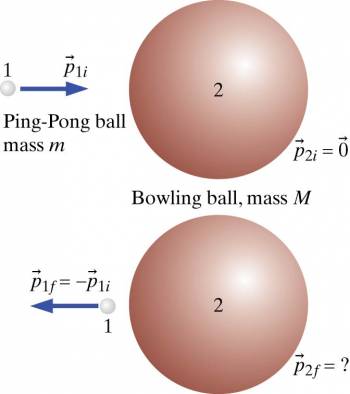
In the world of Physics, a frame of reference is the perspective from which a system is observed. It can be stationary or sometimes it can even be moving at a constant velocity. In some rare cases, the frame of reference moves at an nonconstant velocity and is deemed "noninertial" meaning the basic laws of physics do not apply. Continuing with the trend of examples, pretend you are at a train station observing trains as they pass by. From your stationary frame of reference, you observe that the passenger on the train is moving at the same velocity as the train. However, from a moving frame of reference, say from the eyes of the train conductor, he would view the train passengers as "anchored" to the train.

Experiments that involve scattering are often used to study the structure and behavior of atoms, nuclei, as well as of other small particles. In an experiment like such, a beam of particles collides with other particles. If it is an atomic or nuclear collision, we are unable to observe the curving trajectories inside the tiny region of interaction. Instead, we can only truly observe the trajectories before and after the collision. This is only possible because the particles are at a farther distance apart and have a very weak mutual interaction; this essentially means that the particles are moving almost in a straight line. A good example which demonstrates scattering is the collision between an alpha particle (the nucleus of a helium atom) and the nucleus of a gold atom. One will understand this phenomenon more in depth after first understanding the Rutherford Experiment which will get touched on later.
In England in 1911, a famous experiment was performed by a group of scientists led by Mr. Ernest Rutherford. This experiment, later known as "The Rutherford Experiment", was a tremendous breakthrough for its time because it led to the discovery of the nucleus inside the atom. Rutherford's experiment involved the scattering of a high-speed alpha particle (now known as a helium nuclei - 2 protons and 2 neutrons) as it was shot at a thin gold foil (consisting of a nuclei with 79 protons and 118 neutrons). In the experiment, Rutherford and his team discovered that the velocity of the alpha particles was not high enough to allow the particles to make actual contact with the gold nucleus. Although they never actually made contact, it is still deemed a collision because there exists a sizable force between the alpha particle and the gold nucleus over a very short period of time. In conclusion, we say the alpha particle is "scattered" by its interaction with the nucleus of a gold atom and experiments like such are called "scattering" experiments.
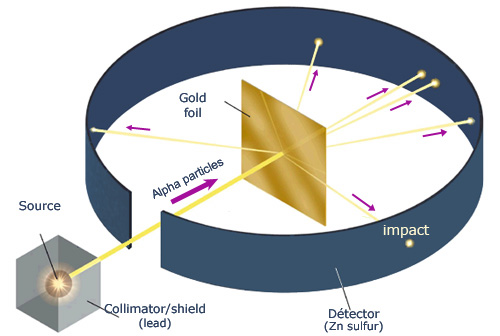
The coefficient of restitution is a measure of the elasticity in a collision. It is the ratio of the differences in velocities before and after the collision. The coefficient is evaluated by taking the difference in the velocities of the colliding objects after the collision and dividing by the difference in the velocities of the colliding objects before the collision.
All of the following information was collected from the Matter and Interactions 4th Edition physics textbook. The book is cited as follows...
Chabay, Ruth W., and Bruce A. Sherwood. "Chapter 10: Collisions." Matter & Interactions. Fourth Edition ed. Wiley, 2015. 383-409. Print.
Fields
- Electric Field of a
- Charge Density
- Superposition Principle
- Electric Potential
- Potential Difference Path Independence
- Potential Difference in a Uniform Field
- Potential Difference of point charge in a non-Uniform Field
- Potential Difference at One Location
- Sign of Potential Difference
- Potential Difference in an Insulator
- Energy Density and Electric Field
- Systems of Charged Objects
- Electric Force
- Polarization
- Charge Motion in Metals
- Charge Transfer
- Magnetic Field
- Combining Electric and Magnetic Forces
Simple Circuits
- Components
- Steady State
- Non Steady State
- Charging and Discharging a Capacitor
- Work and Power In A Circuit
- Thin and Thick Wires
- Node Rule
- Loop Rule
- Resistivity
- Power in a circuit
- Ammeters,Voltmeters,Ohmmeters
- Current
- Ohm's Law
- Series Circuits
- Parallel Circuits
- RC
- Parallel Circuits vs. Series Circuits
- AC vs DC
- Charge in a RC Circuit
- Current in a RC circuit
- Circular Loop of Wire
- Current in a RL Circuit
- RL Circuit
- Feedback
- Transformers (Circuits)
- Resistors and Conductivity
- Semiconductor Devices
- Insulators
- Voltage
Maxwell's Equations
Radiation
- Producing a Radiative Electric Field
- Sinusoidal Electromagnetic Radiaton
- Lenses
- Energy and Momentum Analysis in Radiation
- Electromagnetic Propagation
- Snell's Law
- Effects of Radiation on Matter
- Light Propagation Through a Medium
- Light Scaterring: Why is the Sky Blue
- Light Refraction: Bending of light
- Cherenkov Radiation
- Rayleigh Effect
- Image Formation
Sound
Waves
Real Life Applications of Electromagnetic Principles
- Electromagnetic Junkyard Cranes
- Maglev Trains
- Spark Plugs
- Metal Detectors
- Speakers
- Radios
- Ampullae of Lorenzini
- Electrocytes
- Generator
- Using Capacitors to Measure Fluid Level
- Cyclotron
- Railgun
- Magnetic Resonance Imaging
- Electric Eels
- Windshield Wipers
- Galvanic Cells
- Magnetoreception
- Memory Storage Devices
Resources
- Commonly used wiki commands Wiki Cheatsheet
- A guide to representing equations in math mode Wiki Math Mode
- A page to keep track of all the physics Constants
- A page for review of Vectors and vector operations
